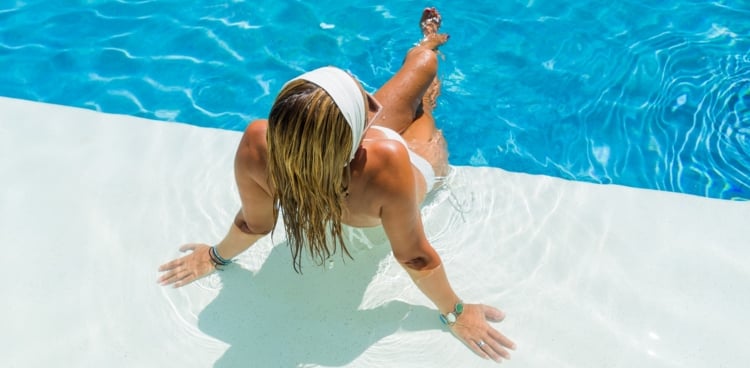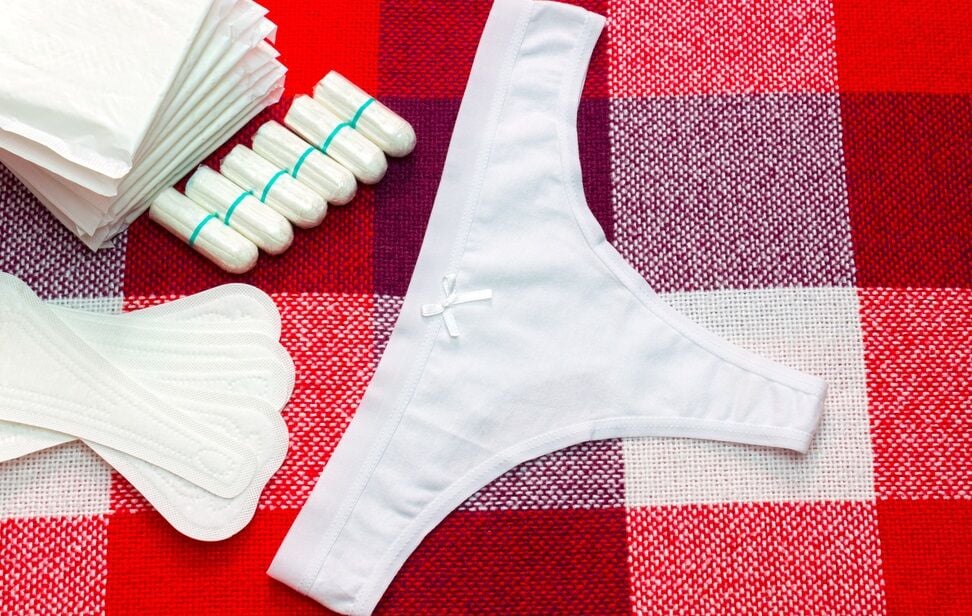There are plenty of myths about swimming while menstruating. Many of these are rooted in cultural taboos and beliefs that hold no water whatsoever. So, can you go swimming on your period? You totally can. Let’s dive into some questions that you might have.
-
Tracking cycle
-
Getting pregnant
-
Pregnancy
-
Help Center
-
Flo for Partners
-
Anonymous Mode
-
Flo app reviews
-
Flo Premium New
-
Secret Chats New
-
Symptom Checker New
-
Your cycle
-
Health 360°
-
Getting pregnant
-
Pregnancy
-
Being a mom
-
LGBTQ+
-
Quizzes
-
Ovulation calculator
-
hCG calculator
-
Pregnancy test calculator
-
Menstrual cycle calculator
-
Period calculator
-
Implantation calculator
-
Pregnancy weeks to months calculator
-
Pregnancy due date calculator
-
IVF and FET due date calculator
-
Due date calculator by ultrasound
-
Medical Affairs
-
Science & Research
-
Pass It On Project New
-
Privacy Portal
-
Press Center
-
Flo Accuracy
-
Careers
-
Contact Us
Swimming on Your Period: 9 Burning Questions Answered


Every piece of content at Flo Health adheres to the highest editorial standards for language, style, and medical accuracy. To learn what we do to deliver the best health and lifestyle insights to you, check out our content review principles.
Swimming during periods
When you have your period, you might feel pain and discomfort due to cramps. Some people might want to limit their activity and focus on rest at this time.
However, one way to take your mind off the discomfort is by engaging in physical activity. While there are many fitness myths, not being able to swim while you’re menstruating is as absurd as it gets. In fact, health experts recommend a number of types of exercise while you’re menstruating, swimming included.
Is it hygienic to swim on your period?
Most people pay close attention to their hygiene during their period. Depending on your comfort level, you may feel more cautious about swimming at this time. Nevertheless, it’s absolutely possible to swim during your period.
Both indoor and outdoor swimming pools add a halogen to the water — either chlorine or bromine.
What do these chemicals do? They kill the bacteria and other microbes that accumulate in a warm, wet place where lots of people swim. In treated water, the chance of getting an infection when swimming in a pool is, thankfully, low. Some doctors recommend avoiding lake or ocean swimming due to a greater risk of infection, as these bodies of water can’t be treated with a halogen.
If you wear sanitary products, make sure to keep any used ones out of the water because they could pose a health risk to other swimmers.
Will swimming worsen cramps?
When you think about it, swimming seems like it could aggravate cramps in your lower back and tummy. Instead, studies have shown that physical exercise — including swimming — can help take your mind off the discomfort and actually relieve soreness.
So, if you’re still wondering, “Will swimming worsen my cramps?” here is the explanation. The soothing lapping of the water over your body and the water’s buoyancy have a calming effect on your muscles. This can reduce pain and bloating that may be associated with your periods.
Can you swim while wearing a tampon?
Yes, you can! In fact, tampons are some of the most suitable sanitary products for taking a dip in the water while on your period.
Before you get into the water, insert the tampon. This will allow it to absorb menstrual blood instead of water.
When you get out of the water, take out the used tampon and insert a fresh one.
It’s important to change your tampon every eight hours to reduce the risk of toxic shock syndrome.
Keep a stash of extra tampons for whenever you want to get back into the water.
Take a quiz
Find out what you can do with our Health Assistant
Take a quiz

Find the Best Period Product For You
Read medically reviewed articles on topics like this
How to swim on your period without a tampon
Tampons are not the only product you can use in the water. With the right sanitary products, you can do more than just dip a toe in the water. You can dive right in!
Here are some products that will help you feel comfortable and confident in the water.
Menstrual cup
If you’re looking for something besides tampons, you can opt for the similarly effective menstrual cup.
Unlike tampons, which are made out of cotton, menstrual cups consist of rubber or silicone. This means the cup collects menstrual blood without absorbing it like a tampon does.
A cup also makes swimming during your period much more hygienic because it does not absorb any of the surrounding water.
On a day when you have a lighter flow, you can use one cup and change it every 12 hours. For days with a heavy flow, you can take breaks from the water and empty your cup. If you have a reusable cup, it’s important to wash it properly before inserting it again.
Period pads for swimming
If menstrual cups aren’t an option, you may still be wondering how to swim on your period without a tampon.
Getting into the water with a pad is a bit trickier when compared to using tampons or a menstrual cup. Pads are super absorbent; if they come into contact with water, they will become useless.
When disposable pads get wet, they can slip out from under your swimsuit.
A pad without wings will be the most discrete, as it won’t peek out from your clothes. Instead of getting your whole body wet, you may decide to sit at the edge of the pool with your feet dangling in the water. If you’re at the beach, you can wade through the water, which will keep your pad dry.
If you do choose to get in the water, you can wear dark-colored shorts over your swim bottoms. This will make the pad less obtrusive and hide any leakage.

Waterproof pants
If you’re going to the beach on your period, waterproof or leak-proof pants can offer an extra layer of protection. These options are especially helpful if you’d rather focus on having fun instead of monitoring your sanitary products.
The outside surface of these pants is waterproof, so no water can get in to encourage any leakages. The elastic edges also ensure a snug fit.
These pants have an absorbent gusset near your pelvis; it not only absorbs the blood but also dries quickly.
Some styles of pants have a space for a pad. The snugness and waterproofing keep the pad dry, so it will only absorb your flow and not the water.
Does your period stop when you’re in the water?
When you get into the water, your menstrual bleeding doesn’t stop, but the blood doesn’t flow out at the same rate either.
Why? This is because the water exerts pressure on your vagina, which counteracts the effect of gravity on your flow.
However, if you do something that exceeds the counterpressure of the water — like sneezing or coughing — some blood will get into the water.
Can I go to the beach on my period without wanting to swim?

Yes, you can tailor your activity level to whatever makes you comfortable. This varies for everybody based on personal factors like your flow, the time of year, the friends you’re with, etc. If you’d prefer, you can relax and watch the waves or other people. Also, you can wade through the water without actually going in for a swim.
If you plan to swim outside, don't forget to put on sunscreen. This is especially important if you’re prone to acne, as sunshine and periods can increase your risk of breakouts or aggravate existing acne.
How do Olympic swimmers manage their periods?
When you are cheering for Olympic swimmers, you may have wondered how they deal with their menstrual flow while competing.
Many athletes who do competitive swimming during periods use tampons and menstrual cups to keep their flow in check.
Some athletes may not have regular periods due to their intense exercise regimen. Others opt for birth control, which can alter their cycle so that they don’t have full periods.
Will sharks attack me?
Sharks can smell small amounts of blood in water. However, there’s no evidence suggesting that people on their periods are more prone to shark attacks.
When should I avoid swimming?
It’s always your choice whether to swim during your period — or at any other time, for that matter. If you don’t feel up to it, you have every right to make the best choice for your body at that time.
If you have symptoms like a fever or feel otherwise unwell, it’s best not to swim. Staying home to rest is always a safe option.


Hey, I'm Anique
I started using Flo app to track my period and ovulation because we wanted to have a baby.


The Flo app helped me learn about my body and spot ovulation signs during our conception journey.


I vividly
remember the day
that we switched
Flo into
Pregnancy Mode — it was
such a special
moment.
Real stories, real results
Learn how the Flo app became an amazing cheerleader for us on our conception journey.
References
Pauli, Samuel A., and Sarah L. Berga. “Athletic Amenorrhea: Energy Deficit or Psychogenic Challenge?” Annals of the New York Academy of Sciences, U.S. National Library of Medicine, Sept. 2010, www.ncbi.nlm.nih.gov/pmc/articles/PMC2941235/.
Armour, Mike et al. “Exercise for Dysmenorrhoea.” The Cochrane Database of Systematic Reviews, U.S. National Library of Medicine, pubmed.ncbi.nlm.nih.gov/31538328/.
“Menstruation and Sharks.” Florida Museum, 1 Aug. 2019, www.floridamuseum.ufl.edu/shark-attacks/reduce-risk/menstruation/.




